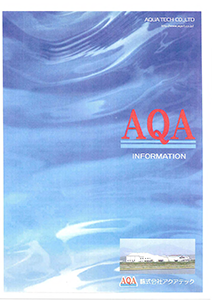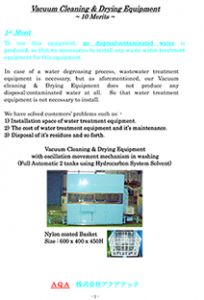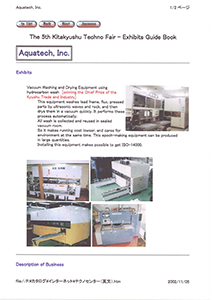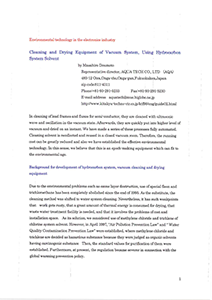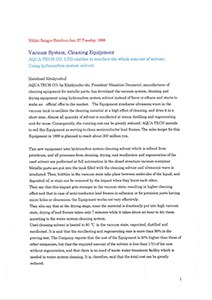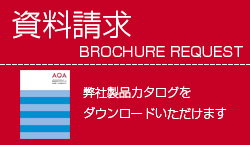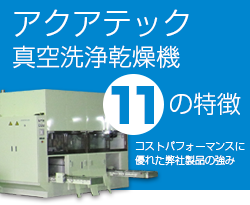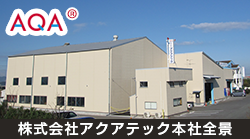English Infomation
- AQA®-Product-catalog
- Vacuum-Cleaning-&-Drying-Equipment-10Merit
- The-5th-Kitakyushu-Techno-Fair–Exhibits-Guide-Book
- Environmental-technology-in-the-electronics-industry
- Nikkei-Sangyo-Shinbun
Vacuum Cleaning & Drying Equipment
Cleaning Laboratory Center
AQA® AQUATECH CO.LTD
Head
Office :485-12 Oira,Onga-cho,Onga-gun,Fukuokaken,Japan
Factory:Zip code : 811-4311
Phone : +81-93-291-5231
Fax : +81-93-291-5230
Wash Test Plant: Phone : +81-93-291-5233
E-mail address domotoaqa-t.co.jp
URL http://www.aqa-t.co.jp
Vacuum Cleaning & Drying Equipmen
— semi-automatic type —
— Full automatic continuous type —
Purpose
- Cleaning of short-size, lead frame material
- Cleaning and drying of press parts
- Cleaning and drying after lapping
- Cleaning and drying before heat treatment
- Cleaning and drying before painting
- Removal of flux and resin
Feature
- As for blind hole parts, because of vacuum drawing, the air accumulated at the blind hole is blown off so that the cleaning solution can enter into deeply. It enables to perform perfect cleaning.
- After deaeration in vacuuming, ultrasonic wave is applied. It can give stronger cavitation, which brings out the highest cleaning effect.
- Even in such a case of short-size, lead frame material on which oil is deposited and stuck about 0.15 mm thick, the flash effect of ultrasonic wave, oscillation, and vacuum can realize perfect cleaning for a short time.
- Drying is the biggest feature.
Before drying, finish cleaning by steam is performed. After that, the material is made into high vacuum at a stroke, then followed by bumping. Thus, this enables to perform ultra-high speed drying.
- Vacuum distillation regenerator is built in this equipment. Dissolved oil is continuously regenerated so as to circulate new solution at all times.
- Since all processes are carried out in the vacuum, it is of closed structure. Exhausted air is recollected and reused, waste solution is condensed after being boiled, and taken out. Thus, the running cost is 1/5 or 1/10 of that in conventional way using ethane, trichlene, methylene chloride.
- As safety measures, it is equipped with possible safety appliances such as oil pan, increased safety apparatus, indirect heating, air barge, interlock, fire preventing damper, automatic break of air and power, automatic fire extinguishing system.
- Because of exhaust air recycling, this equipment always blows the air at the temperature less than 35℃.
- We can provide actual testing equipment, so that you can prove by testing at all times.
Basic Equipment Drawing Type I
(Working weight 40kg)
Specification
- Basket size
Square cage 300 x 200 x 150 H
- Cleaning processes
Vacuum dipping, ultrasonic wave cleaning + Oscillation → Vacuum finish cleaning + Vacuum drying
- Primary side utility
1)Electricity Ф3 200V about 21kW
2)Air 4 ~6kg/cm3
3)Cooling water 50 /
4)Exhaust air 5m3/
Example of cleaning work
Short-size, lead frame material
Revolving cage
Cage (2-stage filling)
Analytical result of residual oil before and after cleaning
| Name of specimen | Normal hexane extracting substance (mg/2 pieces) |
| Vacuum cleaning 360 sec
“ 180 sec “ `2 stg (lower) “ (upper) “ 90 sec After trichlene cleaning Before cleaning |
0.1 or less 0.1 or less 0.1 or less 0.1 or less 0.1 or less 1.1 45.0 |
Measuring method : JIS K 0102 24 normal hexane extracting, weight method
| Name of material | Residual oil (mg/10) | Residual SO4 (ug/l) | Residual oil Cl (ug/l) | Residual oil
in case of methylene chloride |
Before cleaning (per cage) |
| Lead frame No.3
“No.4 “No.5 “No.6 “No.7 “No.8 “No.9 “No.10 |
0.2
0.2 0.2 0.3 0.3 0.3 0.3 0.5 |
1.05
1.11 1.13 0.35 0.44 1.01 3.50 1.23 |
2.25
1.17 1.38 1.28 1.38 1.54 2.37 2.02 |
0.3
0.3 0.3 0.24 0.6 0.6 |
6.900mg
6.900mg |
Unit : residual oil = mg/10 frames
SO4, Cl = ug/frame
Analytical method = infrared absorption method (residual oil)
ion chromatograph method (SO4, Cl)
Specification of Equipment
| Type
Specification |
Type 1 | Type 2 | Type 3 | Type 4 | |
| Basket size (mm) sqare W x L x H, round Ф x L | Square | 300 x 200 x 150 H | 400 x 300 x 200 H | 600 x 400 x 300 H | 700 x 500 x 400 H |
| Round | 200 Фx 300 L | 300 Ф x 400 L | 400 Фx 600 L | 500 Фx 700 L | |
| Work weight (kg) | 20 | 40 | 60 | 80 | |
| Primary utility | Power (kw) | 15 | 20 | 30 | 35 |
| Air 4-6 kg/cal | 400 /min | 600 /min | 900 /min | 1200 /min | |
| Cooling water l/min | 20 | 40 | 80 | 100 | |
| Exhaust air
m3/min |
3 | 5 | 6 | 7 | |
Vacuum Cleaning & Drying Equipment Most applicable before heat treatment and painting
— Full automatic batch type —
Cleaning method
1)Dipping
2)Showering steam cleaning vacuum drying
3)Turning
Features
1)Most applicable for cleaning before and after heat treatment and cleaning before painting
2)Quality steam is always generated from steam generating unit, so finish cleaning is available.
3)All processes from opening/closing of a door to cleaning and drying are automatically operated only through button operation.
4)Tank design of long size one or large size work is possible.
Cleaning basket
1200 x 1200 x 600 H 900 x 900 x 600 H 1200 L x 400 Ф
Analysis data before and after cleaning (in case of blind hole work)
| Name of specimen | Normal hexane extract material (mg/5 pieces) |
| Vacuum cleaning
Standing jig cleaning (600 sec) |
0.1 or less |
| Vacuum cleaning
Horizontal placing cleaning (600 sec |
0.1 or less |
| Organic solvent (trichlene) | 5.4 |
| Water cleaning | 8.0 |
| Before cleaning | 11.7 |
Measuring method : JIS K 0102 24 normal hexane extract weight method
Vacuum Drying
Equipment
Exiting
cleaning equipment
New vacuum drying equipment
Only Vacuum Drying Equipment is additionally installed to the existing hydrocarbon system cleaning equipment!
Features
1.)Since 98% of chemicals which have been conventionally discharged into the atmosphere is recollected and recycled, the running cost can be reduced to 1/5 or 1/10. At the same time, it can diminish the environmental load.
2.)As a standard, finish cleaning unit by steam before drying and work heating unit are built in.
Continuous System, Net Conveyor Type Cleaning & Drying Equipment
This is a cleaning & drying equipment using hydrocarbon system cleaning solution, which can automatically deliver hot and dry air after making shower cleaning and cutting off the solution by air blow.
Features
1)Generally, work can be cleaned and dried on-line, and small amount of small articles can be cleaned and dried in a square cage.
2)It is additionally equipped with distilling regenerator, exhaust mist recollector, and automatic fire extinguisher.
Specification
Conveyor width : 150mm
Line speed : 3.0m/min or higher
Square cage : 340 x 140 x 30 mm H, hoop material
Ultrasonic Wave Cleaning Equipment
Ultrasonic oscillator is oscillated at the level of ten thousands times a second. It generates the sound pressure 100 thousands times as large as the sound pressure at which human being can hear. The oscillation is emitted into the cleaning solution, consequently a lot of vacuum bubbles are generated in the cleaning solution. This is called cavitation.
By the movement of the cleaning solution when cavitation is generated and by the energy (impact) when the cavitation is exploded with high atmospheric pressure, the contamination of the article to be cleaned can be removed. This is the principle for ultrasonic wave cleaning.
Oscillating machine
Oscillator
Flange type
Charging type
Vacuum Distilling0Regenerator
By recycling, the running cost can be greatly reduced and reduction of environmental load can be also achieved!
Features
- By adoption of multi-stage, vacuum distilling system, the life of the equipment is greatly extended. ( The machine is practically being used for 1400 working hours only with refilling.)
- Specification with safety, standard equipment, vacuum system, increased safe specification, indirect heating, air barge, preventive measures against overheating etc.
- Oil is automatically boiled off with timer By boiling off, the waste oil amount is reduced to 1/10!
Flow sheet of Vacuum Distilling Regenerator
Cooling water outlet
Cooling water inlet
Heat exchanger
Vacuum gage
Distilling pan Condenser Reserve tank New solution outlet
Heater
- Electric heating system
- Steam heating system Vacuum pump
Filter Solution inlet
| Specifi-
cation Type |
Recycled amount l/hr
(petroleum Class 2) |
power 3 phase 200V(kw) | Cooling water l/min | Air 4~6kg/cm2
N l/min |
Steam
(in case of steam specification) |
Size of machine | |
| Electric system | Steam system | ||||||
| Type 1 | 35~50 | 6 | 1 | Abt 15 | 100 | Pressure :
3kg/cm2 or higher Required amount: 9kg/hr |
700 x 800 x 1950 H |
| Type 2 | 80~100 | 11 | 1 | Abt 30 | 100 | Pressure :
3kg/cm2 or higher Required amount : 20kg/hr |
700 x 800 x 1950 H |
| Type 3 | 150~200 | 22 | 2 | Abt 60 | 100 | Presssure :
3kg/cm2 or higher Required amount : 40kg/hr |
800 x 900 x 1950 H |
Auxiliaries (including option)
Inflammable gas density tester
Automatic fire extinguisher
Cooling tower for cooling water
Stainless steel pump for cooling tower
Water purifier for cooling tower water
Boiler
Hydrocarbon system, new cleaning agent
1)Cleaning power for metallic machining oil is excellent.
2)Drying power is excellent.
3)Extremely low in odor, and good in workability
4)High in chemical and thermal stability
5)Comparatively high in flash point, and high in safety
6)Non-corrosive to metals
7)Less influential to resin
8)Good in recycling due to steam regeneration
9)Easy in control of the solution because its quality is not changed due to distilling regeneration.
10)High in biodegradation among natural environment.
11)Low in toxicity and high in safety to human body
12)Preventive rules against organic solution intoxication (Labor and Safety Law) is not adopted.
| Name of maker | NikkoSekiyuKagakuCo.Ltd | Henkel Japan | Kurare | |
| Name of article | NS clean 100 | P3 rafnit F | Fine top S-110 | |
| B a s i c P r o p e r t i e s |
Density (15 ℃) (g/cm3) | 0.734 | 0.8 | 0.927 |
| Steam specific gravity (air =1) | 4.9 | 4.1 | ||
| Boiling point (℃) Initial boiling point | 169 | 175 | 174 | |
| Ending point | 173 | 200 | ||
| Pour point or fusing point (℃) | -30.0 | -15℃ or less | ||
| Kinematic viscosity (20℃) (mm3/S) (cSt) | 1.27 | 1.29 | 7.3 | |
| Kinematic viscosity (40℃) | 0.97 | – | (50℃)2.8 | |
| Surface tension (20℃) (mN/m) (dyn/cm) | 21.0 | 28.0 | 29.9 | |
| Latent heat of vaporization [Kcal/kg] | 66.0 | 85.0 | ||
| Specific heat (20℃) [mm3/Kcal/kg.K] | 0.52 | 0.50 | ||
| SP value | 7.7 | – | 9.3 | |
| Refractive index (20℃) | 1.411 | – | 1.9275 | |
| Odor | very slight odor | mild odor | low odor | |
Safety
| Firing point (℃) | 53 | 45 | 68 |
| Explosion limit (vol%) lower limit | 0.8 | 0.78 | |
| Explosion limit (vol%) upper limit | 5.5 | 2.6 | |
| Fire prevention law (hazardous substance Class 4) | Class 2 petroleum | Class 2 petroleum | Class 2 petroleum water soluble |
| Fire prevention law (specified quantity) | 1,000 ltr | 1,000 ltr | 2,000 ltr |
| Labor and Safety Law | |||
| (organic solution intoxication preventing rules) | Not applicable | Not applicable | Not applicable |
| Existing scientific substance No. | Water solubility limitless |
| Name of maker | Alcohol system cleaning agent
AQUA TECH |
|
| Name of article | Aqua No1-50 | |
| B a s i c P r o p e r t i e s |
Density (15 ℃) (g/cm3) | 1.28 |
| Steam specific gravity (air =1) | ||
| Boiling point (℃) Initial boiling point | ||
| Ending point | ||
| Pour point or fusing point (℃) | ||
| Kinematic viscosity (20℃) (mm3/S) (cSt) | 0.68 | |
| Kinematic viscosity (40℃) | ||
| Surface tension (20℃) (mN/m) (dyn/cm) | ||
| Latent heat of vaporization [Kcal/kg] | ||
| Specific heat (20℃) [mm3/Kcal/kg.K] | ||
| SP value | 9.3 | |
| Refractive index (20℃) | 1.9275 | |
| Odor | low odor | |
Safety
| Firing point (℃) | Not measurable |
| Explosion limit (vol%) lower limit | – |
| Explosion limit (vol%) upper limit | – |
| Fire prevention law (hazardous substance Class 4) | Not applicable |
| Fire prevention law (specified quantity) | – |
| Labor and Safety Law | – |
| (organic solution intoxication preventing rules) | Not applicable |
| Existing scientific substance No. |
Safety
| Name of maker | Chlorine system solvent
Reference (reference value) |
|||
| Name of article | Trichloroethylene | Perchloroethylene | Methylene chloride | |
| B a s i c P r o p e r t i e s |
Density (15 ℃) (g/cm3) | 1.464 (20℃) | 1.623(20℃) | 1.326(20℃) |
| Steam specific gravity (air =1) | 4..5 | 5.7 | 2.9 | |
| Boiling point (℃) Initial boiling point | 87 | 121 | 40 | |
| Ending point | ||||
| Pour point or fusing point (℃) | -86.4(fusing point) | -22.4(fusing point) | -96.7(fusing point) | |
| Kinematic viscosity (20℃) (mm3/S) (cSt) | 0.58 | 0.88 | 0.43 | |
| Kinematic viscosity (40℃) | ( | |||
| Surface tension (20℃) (mN/m) (dyn/cm) | 29.5 | 32.3 | 28.1 | |
| Latent heat of vaporization [Kcal/kg] | 57.2 | 50.0 | 78.7 | |
| Specific heat (20℃) [mm3/Kcal/kg.K] | 0.22 | 0.21 | 0.28 | |
| SP value | 9.3 | 9.4 | 9.7 | |
| Refractive index (20℃) | 1.478 | 1.506 | 1.4245 | |
| Odor | sweet odor | sweet odor | ether odor | |
Safety
| Firing point (℃) | Not exist | Not exist | Not exist |
| Explosion limit (vol%) lower limit | 9.3 | 10.8(in oxygen) | 15.5(in oxygen) |
| Explosion limit (vol%) upper limit | 44.8 | 54.5(in oxygen) | 66(in oxygen) |
| Fire prevention law (hazardous substance Class ) | Not applicable | Not applicable | Not applicable |
| Fire prevention law (specified quantity) | 3.7 | 3.0 | 2.1 |
| Labor and Safety Law | |||
| (organic solution intoxication preventing rules) | Class 1 organic solvent | Class 2 organic solvent | Class 2 organic solvent |
| Existing scientific substance No. | 2-105 | 2-114 | 2-36 |
Environmental technology in the electronics industry
Cleaning and Drying Equipment of Vacuum System, Using Hydrocarbon System Solvent
by Masahiro Doumoto
Representative director, AQUA TECH CO., LTD (AQA)
485-12 Oira,Onga-cho,Onga-gun,Fukuokaken,Japan
zip code:811-4311
Phone:+81-93-291-5233 Fax:+81-93-291-5230
E-mail address aquatechmue.biglobe.ne.jp
http://www.kitakyu-techno-ctr.co.jp/ktf98/eng/guide02.html
In cleaning of lead frames and fluxes for semi-conductor, they are cleaned with ultrasonic wave and oscillation in the vacuum state. Afterwards, they are quickly put into higher level of vacuum and dried on an instant. We have made a series of these processes fully automated.
Cleaning solvent is recollected and reused in a closed vacuum room. Therefore, the running cost can be greatly reduced and also we have established the effective environmental technology. In this sense, we believe that this is an epoch-making equipment which can fit to the environmental age.
Background for development of hydrocarbon system, vacuum cleaning and drying equipment
Due to the environmental problems such as ozone layer destruction, use of special fleon and trichloroethane has been completely abolished since the end of 1995. As the substitute, the cleaning method was shifted to water system cleaning. Nevertheless, it has such weakpoints that work gets rusty, that a great amount of thermal energy is consumed for drying, that waste water treatment facility is needed, and that it involves the problems of cost and installation space. As its solution, we considered use of methylene chloride and trichlene of chlorine system solvent. However, in April 1997, “Air Pollution Prevention Law” and “ Water Quality Contamination Prevention Law” were established, where methylene chloride and trichlene are decided as hazardous substance because they were judged as organic solvents having carcinogenic substance Then, the standard values for purification of them were established. Furthermore, at present, the regulation became severer in connection with the global warming prevention policy.
lopmentDeve
Under such background, we took notice of hydrocarbon cleaning solvent. It has the following merrits.
(1)Work does not get rusty while it does in water cleaning.
(2)No waste water treatment facility is needed.
(3)Acid and alkali are not used.
(4)Many makers participate in development of cleaning solvent, resultantly reducing the cost.
Meanwhile, use of hydrocarbon cleaning solvent has a sole demerit of being “inflammable”.
In order to overcome the weakpoint, we have reached the conclusion that “all processes from cleaning up to drying should be conducted in the vacuum.”
Features
Using a cage (size 300 x 200 x 200 H mm) for work to be filled in, we have completed the testing machine of the same specification as real equipment. (see Photo 1, Drawing 1).
We have repeated the cleaning and drying tests many times to obtain a lot of data.
On the basis of the data, we will introduce below the features of what all processes are carried out in the vacuum.
(1)After deaeration in the vacuum, ultrasonic wave is applied. Then, strong cavitation is obtained to bring about the highest cleaning effect…
(2)As cleaning is performed after the material is drawn in the vacuum, blind hole parts can be thoroughly cleaned, since the air accumulated at the blind hole is blown off and the cleaning solution can enter deeply. (see Table 1, Table 2, and Photo 2) Furthermore, even in such a case as short sized, lead frame material on which oil is deposited 0.15mm thick, complete cleaning is available for a short time by the flash effect of ultrasonic wave, oscillation, high level of vacuum after vacuuming. (see Table 3, Table 4, Photo 3, and Photo 4)
(3)In the drying stage, since the material is drastically put into the high level of vacuum, bubbling phenomenon is accompanied, which enables to perform ultra high speed drying.
While it conventionally takes more than 60 minutes to dry short-size, lead frame material, vacuum drying of it takes only 7 minutes. However, in order to dry it within 7 minutes, the preconditions of vacuum, temperature, flash effect etc. must be all fulfilled.
If these pre-conditions are met, all material such as copper system, aluminum system, 42 alloy etc. can be completely dried without decoloring. Such materials are practically dried on the test line. (see Photo 3, Photo 4). And the flow chart for this case is shown in Fig. 2.
(4)Since a vacuum distilling regenerator is built in the Equipment, the dissolved oil is continuously regenerated, resulting in circulating new solution at all times. Table 5 and Table 6 indicate the degree of aging of the cleaning agent, which is analyzed by gas chromatograph after 2,000 hours’ working time. They prove that 99.9% of purity is being kept. Up to now, 4,000 hours of working time have been elapsed without any troubles.
(5)This Equipment is of a closed structure, because every process is conducted in the vacuum state. Furthermore, the exhaust air is recollected and the reused waste solution is condensed and taken out after being boiled down. Consequently the running cost is reduced to 1/5 or 1/10, compared with the cost in the conventional way using ethane and methylene chloride. (see Table 7).
(6)As safety measures, are provided various safety apparatus such as use of oil pan and increased safety, explosion-proof unit, indirect heating system, inner pressure explosion-proof by air barge, interlock standards for water, air, temperature, vacuum etc.. In addition, this Equipment is equipped with alarm system for inflammable gas density, fire preventing damper, automatic fire extinguishing system using carbon dioxide, automatic breakdown of primary side air, automatic breakdown of power, and so forth.
(7)As countermeasures against the global warming problem, the exhaust air is always discharged at the temperature of 35℃ or less.
Theme to be investigated
The major theme to be investigated is selection of the cleaning agent. Because at present many big industries of various field such as petroleum chemical makers, cleaning agent makers, texture makers etc. are involved in the cleaning agent market, resulting in diversifying the sort of the cleaning agent in the market. Some of them are made of a single product of normal paraffin and glycol ether. Others are the one which alcohol solvent or surface active agent is mixed in it. And, in terms of cleaning object, there are various sort of cleaning agent such as those for removal of mineral oil, for removal of water soluble oil, for removal of flux, and for removal of resin. Therefore, wrong selection of the cleaning agent produces no perfect cleaning effect. From this point of view, the pre-test using a real equipment is needed. (see Photo 1).
Some sort of oil contains a lot of chlorine compound as additives. In this case as well, selection of the cleaning agent and setting of regenerating temperature must be exactly searched for.
Wrong selection of these factors may generate spotting or decoloring due to aging change, which is remarkably seen with material such as copper or aluminum.
Another important point which must be put in mind is selection of the cleaning agent whose ingredient is not dissolved or separated by continuous regeneration.
Trend in the future
As substitutes for trichlene or methylene chloride, most cleaning systems have been shifted to the hydrocarbon cleaning. This trend will be probably accelerated, further utilizing its characteristics. Among such a situation, the possible new system for cleaning will be “cleaning using carbon dioxide in the supercritical state”. Though there are many problems in terms of the cost phase at present, it is predicted that electronics parts industry may step up towards realization of this system within the profitable cost in several years
Photo 1 Semi-automatic, batch type, vacuum cleaning and drying equipment.
Fig. 1 Drawing of vacuum cleaning and drying equipment
Control panel Distilling regenerating unit Vacuum pump
Lift cylinder
Motor for driving lift
Work
Chuck
Cooling coil
Ultrasonic wave
Inlet
Vacuum dipping, ultrasonic wave cleaning + oscillation
Vacuum finish cleaning
Vacuum drying
Outlet
Vacuum pump
Specifications
- Basket size : square cage 300 x 200 x 150 H mm
- Cleaning process
vacuum dipping, ultrasonic wave cleaning+oscillation → vacuum finish cleaning+vacuum drying
- Primary side utilities
1) Electricity : φ3 200v abt 21kw
2) Air : 4~6kg/c㎡
3)Cooling water :50 l /min
4) Exhaust air :5 m3/min
Table 1 Analytical data of residual oil before and after cleaning for blind hole work
| Name of specimen | Normal hexane extract material (mg/5 pieces) |
| Vacuum cleaning
Standing jig cleaning (600 sec) |
0.1 or less |
| Vacuum cleaning
Horizontal placing cleaning (600 sec |
0.1 or less |
| Organic solvent (trichlene) | 5.4 |
| Water cleaning | 8.0 |
| Before cleaning | 11.7 |
Measuring method : JIS K 0102 24 normal hexane extracting, weight method
Table 2 Analytical data of residual oil before and after cleaning
| Name of specimen | Normal hexane extracting substance (mg/2 pieces) |
| Vacuum cleaning 360 sec
“ 180 sec “ “ 2 stg (lower) “ “ “ (upper) “ 90 sec After trichlene cleaning Before cleaning |
0.1 or less 0.1 or less 0.1 or less 0.1 or less 0.1 or less 1.1 45.0 |
Measuring method : JIS K 0102 24 normal hexane extracting, weight method
Photo 2 Full automatic, batch type cleaning and drying equipment for short size, lead frame
Photo 3 In-line type, vacuum cleaning and drying equipment for short size, lead frame
Photo 4 In-line type, vacuum cleaning and drying equipment for short size, lead frame
Table 4 Analysis data before and after cleaning
| Name of material | Residual oil (mg/10) | Residual SO4(ug/l) | Residual Cl
(ug/l) |
| Lead frame No.1
“ No.2 “ No.3 “ No.4 “ No.5 “ No.6 “ No.7 |
0.25
0.90 0.30 0.28 0.20 0.36 0.38 |
– –
– – – 0.36 |
–
– – – – 1.07 |
Unit : residual oil = mg/10 frames
SO4, Cl = ug/frame
Analytical method = infrared absorption method (residual oil)
ion chromatograph method (SO4, Cl)
(as per JIS K 0102-1993)
Table 3 Analysis data before and after cleaning
| Name of material | Residual oil (mg/10) | Residual SO4(ug/l) | Residual l Cl
(ug/l) |
Residual oil
in case of methylene chloride |
Before cleaning (per cage) |
| Lead frame No.1
“ No.2 “ No.3 “ No.4 “ No.5 “ No.6 “ No.7 “ No.8 “ No.9 “ No.10 |
0.4
0.3 0.2 0.2 0.2 0.3 0.3 0.3 0.3 0.5 |
0.43
0.43 1.05 1.11 1.13 0.35 0.44 1.01 3.50 1.23 |
2.33
2.00 2.25 2.17 1.38 1.28 1.38 1.54 2.37 2.02 |
0.6
0.6 0.3 0.3 0.3 0.24 0.6 0.6 |
6.900mg
6.900mg |
Unit : residual oil = mg/10 frames
SO4, Cl = ug/frame
Analytical method = infrared absorption method (residual oil)
ion chromatograph method (SO4, Cl)
(as per JIS K 0102-1993)
Fig. 2 Vacuum system, full automatic cleaning equipment
Vacuum drying Vacuum dip Vacuum dip Vacuum dip Vacuum dip
cleaning 4 cleaning 3 cleaning 2 cleaning 1
Unload Ultrasonic wave Ultrasonic wave Ultrasonic wave Ultrasonic wave Load
Discharge hole Vacuum Vacuum Exhaust
distilling distilling tank
regenerator regenerator
| Specifications | Content |
| 1. Cleaning agent | Hydrocarbon system cleaning agent |
| 2. Standard tact time | 10 minutes/2 cases |
| 3. Transfer method | basket 2 stages delivery in order |
| 4.Ultrasonic wave | Output 1,200w x Class 4
3 kinds (28, 45, 100 Hz) |
Table 5 Hydrocarbon system cleaning agent (new agent)
| Analyzing method, measuring conditions | |
| Gas chromatograph | SHIMAZU-make, GC14A/FID |
| Column | silica capillaryDB-1(J&W Sci),
0.25mmφ x 30m |
| Heating condition | 70℃(5min)5℃/min, 100℃(0min)20℃/min
300℃(20min) |
| Carrier gas | He flowrate 2.1ml/min, split ratio 1:150 |
Table 6 Hydrocarbon system cleaning agent
(after 2000 hours of continuous distilling regeneration)
| Result of measurement | ||
| Specimen | NS clean density (%) | Machining oil (%) |
| 1) | 99.9 | 0.04 |
| 2) | 99.9 | 0.04 |
Table 7 Comparison of running cost
| Item | Specification | Unit cost (yen) | per month | monthly cost(yen) | |
| Cleaning agent | Consuming amount
Waste solution |
5 l/day
80% of oil content is taken as waste solution |
300 yen/l
300 yen/l |
22 days
12.5 l |
33,000
3,750 |
| Consum-able | Filter element
Vacuum pump oil Vacuum pump grease |
75ψ x 250 20 | 1,300 yen
3,500yen/4 25,000yen/kg |
4 pcs
0.5 15.3 |
5,200
438 383 |
| Primary side utilities | Electricity | ψ3, 200V 30kWhr | kW | ||
| Air for driving
Air for blowing |
average using amoount 200Nl/min
none |
m3 | |||
| Waste water
Cooling water Exhaust air |
none
80 l/min tower water is OK. 10m3/min |
||||
| Working hour | day : 8 hours
month : 22 days 176 hrs/month |
The price of cleaning agent is that of standard hydrocarbon system cleaning agent. | |||
Nikkei Sangyo Shimbun Jan. 27 Tuesday, 1998
Vacuum System, Cleaning Equipment AQUA TECH CO. LTD enables to recollect the whole amount of solvent.Using hydrocarbon system solvent
[datelined Kitakyushu]
AQUA TECH CO. (in Kitakyushu-shi, President: Masahiro Doumoto), manufacturer of cleaning equipment for metallic parts, has developed the vacuum system, cleaning and drying equipment using hydrocarbon system solvent instead of freon or ethane and starts to make an official offer in the market. The Equipment irradiates ultrasonic wave in the vacuum tank to oscillate the cleaning material at a high effect of cleaning, and dries it in a short time. Almost all quantity of solvent is recollected at steam distilling and regenerating unit for reuse. Consequently, the running cost can be greatly reduced. AQUA TECH intends to sell this Equipment as serving to clean semiconductor lead frames. The sales target for this Equipment in 1998 is planned to reach about 300 million yen.
This new equipment uses hydrocarbon system cleaning solvent which is refined from petroleum, and all processes from cleaning, drying, and recollection and regeneration of the used solvent are performed at full automation in the closed structure vacuum container.
Metallic parts are put into the tank filled with the cleaning solvent and ultrasonic wave is irradiated. Then, bubbles in the vacuum state take place between molecules of the liquid, and deposited oil or stain can be removed by the impact when they burst each other..
They say that this impact gets stronger in the vacuum state, resulting in higher cleaning effect and that in case of semi-conductor lead frames in adhesion or for precision parts having micro holes or clearances, the Equipment works out very effectively.
They also say that at the drying stage, since the material is drastically put into high vacuum state, drying of lead frames takes only 7 minutes while it takes about an hour to dry them according to the water system cleaning system.
Used cleaning solvent is heated to 80 ℃ in the vacuum state, vaporized, distilled and recollected. It is said that the recollecting and regenerating rate is more than 99%.in the proving test. The Company reports that the cost of the Equipment is 30% higher than those of other companies, but that the required amount of the solvent is less than 1/10 of the case without regeneration, and that there is no need of waste water treatment facility which is needed in water system cleaning. It is, therefore, said that the total cost can be greatly reduced.
In the end of 1995, conventional use of special freon or trichloroethane was legally abolished from the viewpoint of environmental influences such as destruction of ozone layer. Then, the hydrocarbon system cleaning agent is prevailing as substitutes for them. However, it has a weekpoint that there is a fear of fire accident because of low firing point. But it is reported that there is no danger of such in the vacuum state.
AQUA TECH CO. completed the test equipment for evidence test in October l997. And some big lead frame makers have already given orders for this new equipment.
Nikkan Kogyo Shimbun, March 18, Wednesday 1998
Cleaning and drying of metallic parts Solvent can be repeatedly used. AQUA TECH CO. has developed the vacuum equipment.
[datelined Kitakushu]
AQUA TECH CO. (6-13-20 Honjo-higashi, Yahata-nishiku, Kitakyushu-shi, President: Masahiro Doumoto, phone: 093-692-3461) starts to sell on real commercial base the vacuum system, automatic cleaning and drying equipment (see photo) using hydrocarbon system solvent. Because it does not use freon or ethane, it is “gentle” to the environment. The feature of this equipment is that cleaning of lead frames becomes available. The price amounts to 10 million to 40 million yen, depending on the quantity to be processed. The sales target of this equipment for 1998 is planned to be about 300 million yen.
Using hydrocarbon system solvent which is refined form rough oil, all processes from cleaning to drying, and recollection and regeneration of used solvent are automatically performed in the vacuum, closed container. Though hydrocarbon system solvent has a weakpoint of being inflammable, there is no fear of fire accident because it works in the vacuum state.
As for cleaning, at first, cleaning object material such as metallic parts are put into the water tank with solvent dissolved in, then oscillation takes place by ultrasonic wave. Bubbles generate by oscillation. By utilizing the impact when bubbles burst, deposited oil or dirt are removed. Because bubbles burst out in the vacuum container, the impact gets strong to increase the cleaning effect. It is also able to clean micro holes of lead frames or precision parts. And, in the drying stage, where the material is suddenly placed into high level of vacuum, instantaneous boiling occurs. Thus, drying of lead frames can be performed at super high speed as fast as only seven minutes whilst it conventionally has taken about an hour.
Furthermore, the vacuum distilling and regenerating unit is built in this equipment, where used solvent is heated up to 80℃ in the vacuum, evaporated, distilled, and recollected at the “recovery rate of 99.8%” This regenerated steam also serves to warm up the cleaning material and to prevent from dew formation. And, because of the closed structure, the required amount of solvent is about one-fifth, in comparison with the equipment without regenerating unit. And there is no necessity to install waste water treatment facility.
Therefore, this equipment greatly contributes to reduction of the total cost.










